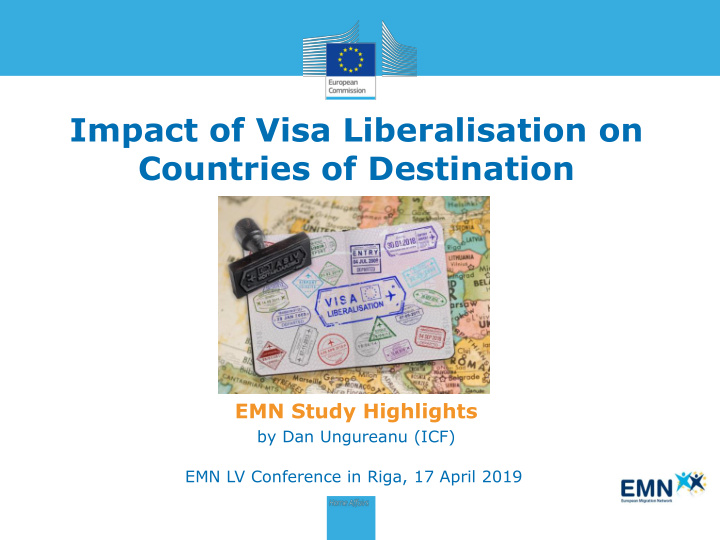



Impact of Visa Liberalisation on Countries of Destination EMN Study Highlights by Dan Ungureanu (ICF) EMN LV Conference in Riga, 17 April 2019
Outline – Synthesis Report 1. Aim and scope of the study 2. Legal and policy framework 3. Method 4. The impact of visa liberalisation 5. Challenges and measures 6. Examples of actions taken
1. Aim and scope of the study Aim of the study Scope of the study 26 EMN NCPs To explore the impact of visa 5 Western Balkan states liberalisation in specific areas 3 Eastern Partnership states and analyze trends in irregular migration that have been observed in the EU and Norway. 2007 - 2017
2. Legal and policy framework Visa Code and Regulation Visa Liberalisation Dialogues A common EU visa policy for Staged process started with visa short-term Schengen visas (90 facilitation agreements (coupled days in any 180 days period). with readmission agreements). Suspension Mechanism Ensures that visa-free travel is not misused and can reintroduce temporary visa requirements under defined conditions.
3. Method Eurostat and National Data Indicators Statistics were collected for the Selected based on the Commission period 2007 – 2017 to cover the benchmarks to monitor the fulfilment years before and after visa of the visa liberalisation liberalisation. requirements. Limitations Focus on short-term visa liberalisation (long-stay beyond scope); Focus on countries of destination (EU + NO, not third countries); Correlation not causation between visa liberalisation and findings; United Kingdom and Ireland apply national visa requirements;
4. The impact of visa liberalisation Indirect Impacts Direct Impacts An immediate increase in short Facilitation of access to the • term travel to the EU; labour market in specific Member A reduction in the workload of States; consulate staff; • Higher levels of cooperation Increased border control during return and readmission activities to avoid the misuse of procedures with visa-free visa liberalisation. countries.
5. Challenges and measures Measures Challenges An overall increase in the Designation of visa-free number of (unfounded) asylum countries as safe countries of applications from visa-free origin; countries; New information campaigns Increased numbers of visa-free and cooperation with visa-free nationals overstaying their visa countries authorities; period; Strengthening penalties to Increase in criminal activities. prevent the misuse of visa liberalisation.
6. Examples of actions taken Actions Belgium organised targeted information campaigns to curb the influx of asylum applications (effective with North Macedonia, Serbia and Bosnia and Herzegovina, less so with Albania and Georgia); Germany introduced specific restrictions in accommodation, social benefits and access to the labour market and integration measures for asylum applicants from safe countries of origin (includes study states); France implemented action plans to tackle irregular migration from Albania and Georgia and reinforced cooperation with Albanian and Georgian national authorities.
Find out more… The Visa Liberalisation Study was published on 25 March 2019 and more information is available on the EMN website: Synthesis Report Inform Flash
Thank you! Dan Ungureanu dan.ungureanu@icf.com EMN Service Provider EMN Website: www.emn.europa.eu EMN on Twitter: @EMNMigration General contact: emn@icf.com
Recommend
More recommend